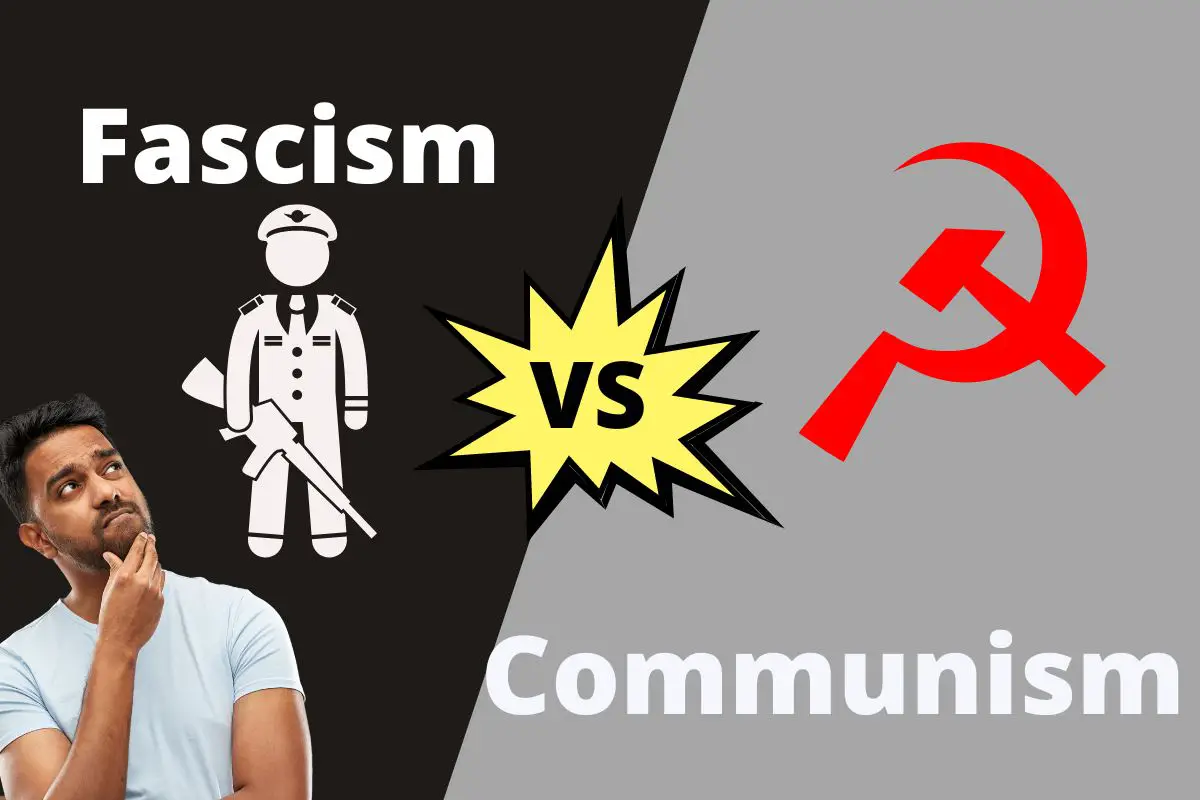The main difference between fascism and communism is that fascists want a highly-centralized, highly-authoritative governing body to control resources, while communists want the public to own and control resources equally.
Following World Wars I and II, fascism and communism rose to prominence. Fascism gained a reputation in Germany under Adolf Hitler’s reign and extended to several other countries. On the other hand, communism was developed by Karl Marx and Fredrich Engels prior to fascism.
Table of Contents
Fascism vs Communism
| Fascism | vs | Communism |
| The leaders intended to establish an intensely patriotic government that controlled and directed the economy. | Meaning | The ideology of communism is that the State should control the means of production in a society. |
| Supports a one-party system and opposed liberal democracy. | Function | State should outlaw all forms of private property ownership |
| Entities privately held by individual | Coordination in the Economy | Equal support |
| Rigid class system | Social Organization | No class division or classes |
| State owns the land | Ownership | No ownership |
| Less freedom | Free Will | More freedom |
What is Fascism?
Fascism is very right-wing on the political spectrum. Fascist ideology includes an authoritarian, centralized political structure and intense nationalism.
Benito Mussolini created a fascist state in Italy, leading to World War I.
The term fascist often is used pejoratively and can refer to a political bully. For example, Fidel Castro’s influence in Cuba has been referred to as fascism, but it’s technically communism.
Fascism supported a one-party system and opposed liberal democracy. It was also a system that disapproved of both socialism and capitalism. Contrary to these ideals, fascism promoted economic self-sufficiency.
Historically, fascism has promoted violence committed in the name of politics. For the sake of dominance, this was seen as genuine. People’s desire for national harmony under strong leadership caused them to embrace fascism.

What is Communism?
Communism is based on the idea that the State should control the means of production in a society. It’s a philosophy that favors public ownership over private property and a profit-driven economy.

The communist society created a dilemma in which the State would outlaw all forms of private property ownership. In other terms, the production methods are communally owned and aren’t only concentrated in a few areas in communist countries.
Everyone contributed according to their capacity and received according to their needs. This was a frequent adage throughout the communist revolution. As a consequence, the demands of an individual would be subordinate to those of society.
Community-controlled Resources
The primary production methods and available natural resources are under the community’s control under a communist system. Therefore, it might be a more advanced type of national socialism. In the second part of the 19th century, Karl Marx and Friedrich Engels created Marxism as a political and economic ideology.
Marxism
This idea originated from the notion that the affluent oppressed working populations and civilizations eventually experience class awareness. According to the leaders, a revolutionary battle would settle the disagreements.
Preparing for the Revolution
Joseph Stalin would eventually serve as the General Secretary of the Communist Party. Finally, Stalin led the Soviet Union to become both a totalitarian and authoritarian state. An authoritarian government means a country’s political system limits plurality and is entirely centralized.
The proletariat (working class) rebelled against the bourgeoisie during this revolution, establishing a communist state.
Here, nation or country may refer to a group or assembly of individuals who share a sense of identity determined by location, race, or culture. These all have the potential to trend toward fascism and prioritize nationalism above all other types of allegiance.
The leaders intended to establish an intensely patriotic government that controlled and directed the economy. Additionally, it aimed to make the country into something lovely with a free-standing structure and culture.
In summary, what resulted was a dictatorial, ultra-nationalistic regime that was content with crushing dissent to advance its goals.
Differences Between Communism and Fascism
During the 19th and 20th centuries in Europe, communism and fascism gained traction. There is a clear distinction between fascism and communism, even though they both have anti-democratic governmental structures.
Roles in the Economy
In communism, all choices, including investment, output, and resource distribution, are coordinated via economic planning. Instead of using dollars, planning is in terms of physical units.
Businesses are ostensibly privately held in fascism, but the State controls their investments and outputs. Instead of using money, anticipated labor production forms the basis of planning.
Free Will
Either the group’s vote in communism or the State’s leaders in fascism decide on economic and political matters on everyone else’s behalf. In reality, the authorities employ rallies, coercion, propaganda, and other methods to keep the masses under control.
Social Organization
There are no longer any class divisions in communism. Communism creates a society where the public owns the means of production and employs its people.
In Italian fascism, a rigid class system was thought to be necessary to avoid disorder. Class differences were nonexistent for the German Nazi regime, although Nazism holds that certain races are superior.
Benito Mussolini founded and led the National Fascist Party in Italy. Mussolini’s eventual goal was to create a totalitarian state, preventing personal freedoms and limiting individual rights.
Ownership Organization
Since no entity or person owns the means of production in communism, they’re collectively owned. Usefulness is valued above ownership in terms of importance.
Although the means of production are privately held in fascism, the State controls them. Private company ownership complies with state interests and direction.

